EU climate package explained
- Published
In 2009 the EU adopted a wide-ranging package on climate change, following months of tough negotiations in the 27-nation bloc.

EU member states still rely heavily on fossil fuels for power
The package focuses on three areas: emissions cuts, renewables and energy efficiency.
Changes have been made to the original package unveiled by the European Commission in January 2008, to address European industrialists' concerns about green measures potentially making them uncompetitive at a time of weak global demand.
But the overall 20-20-20 targets have been kept: a 20% cut in emissions of greenhouse gases by 2020, compared with 1990 levels; a 20% increase in the share of renewables in the energy mix; and a 20% cut in energy consumption.
GLOBAL WARMING
The EU package builds on the international commitments made under the 1997 Kyoto Protocol. These commitments only run until 2012.
EU governments want other major polluters worldwide to adopt targets similar to the EU's - especially the US, the biggest polluter.
But there was widespread disappointment at the outcome of the UN conference on climate change held in Copenhagen in December 2009. It failed to produce the binding global targets that the EU wanted.
Copenhagen's last-minute deal did not explain in detail how the target of limiting global warming to 2C this century could be achieved.
US President Barack Obama put green targets on the agenda in a way that the Bush administration never did. He has pledged a 17% cut in emissions from 2005 levels by 2020. But in real terms that amounts to just a few percentage points, the BBC's environment analyst Richard Black says, as US emissions have risen by about 15% since 1990.
Moreover, there are signs that the US Congress will not go as far as backing a 17% cut.
China, India and other significant industrial powers will also have to come on board if global warming is to be tackled effectively.
Scientists say global warming is already happening and predict that if the planet's temperature rises more than 2C above the pre-industrial level there will be more extreme weather phenomena and rising sea levels, threatening coastal areas.
Climate specialists, including the European Environment Agency, say northern Europe is getting wetter and the south drier, Arctic summer sea ice is melting faster than expected, many plant and animal species are moving further north and uphill.
Deforestation and the burning of fossil fuels are blamed for the warming effect, because they increase carbon dioxide (CO2) in the atmosphere, the main greenhouse gas.
EMISSIONS CUTS AND THE ETS
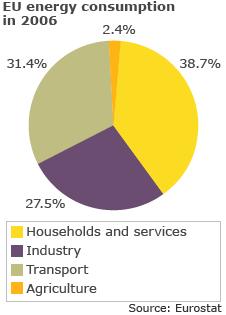
The European Commission and EU governments agreed on the target of cutting greenhouse gases by at least 20% by 2020, compared with 1990 levels.
The target will rise to 30% if an international agreement is reached committing other developed countries and the more advanced developing nations to comparable emission reductions.
The EU launched its pioneering Emissions Trading Scheme (ETS) in 2005. But to meet the new targets for emissions cuts changes to the ETS are required.
Under the ETS, permits for emitting CO2 are distributed under a system of national allocations. The permits are traded - so big polluters can buy extra ones from greener enterprises.
The EU aims to reduce the allocations by 21% from 2005 levels by 2020. And there is to be one EU-wide cap on the number of permits, rather than individual national allocation plans.
The ETS covers about 10,000 heavy industrial plants across the EU - notably power plants, oil refineries and steel mills - which together account for almost half the EU's CO2 emissions, the commission says.
All major industrial emitters of CO2 are to be brought under the ETS eventually and the scheme will also include greenhouse gases other than CO2 - nitrous oxide and perfluorocarbons.
In the first and second ETS trading periods (2005-2012) the EU decided to give most of the CO2 permits to power plants and energy-intensive industries for free.
The original plan was that from 2013 such enterprises would have to buy all their permits at auction. But industrial lobbies, particularly in Germany and Italy, complained that the cost would be too great, at a time of economic hardship.
Poland, whose power plants are 95% reliant on coal, argued that the extra cost of buying permits would mean an unacceptable rise in electricity prices - a fear echoed by its former communist neighbours.
So EU leaders made some concessions at their December 2008 summit - concessions denounced by green campaigners.
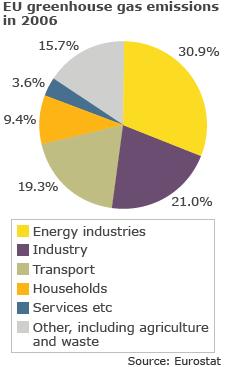
Full auctioning will be delayed for industrial sectors where there is a proven risk of "carbon leakage" - that is, a risk that jobs or plant could be relocated to non-EU countries where the rules on emissions are more lax.
New data will be needed to determine which sectors qualify for this exemption, or "derogation". The European Commission aims to determine those sectors by 2010.
Poland and other former communist countries will get about 12% of the revenues from the ETS, as help to clean up their heavy industry.
Plants in the poorer EU states still heavily reliant on fossil fuel, including ones which were not integrated into the main EU power network in 2007, will only have to buy 30% of their CO2 permits in 2013. Full auctioning will not apply to them until 2020.
A substantial amount of the emissions cuts will be achieved through carbon "offsets" - the practice whereby enterprises in the EU get carbon credits by sponsoring green projects in developing countries. The projects have to comply with the mechanisms set up by the Kyoto Protocol.
Credits not already used up in the 2008-2012 ETS period can be "banked" and carried over into the 2013-2020 period. The commission says more than one-third of the required 20% emissions cut will be achieved that way.
Some environmentalists say the use of carbon offsets will seriously weaken the impact of the EU's climate package in Europe.
Green MEP Claude Turmes, one of the European Parliament's top negotiators on the package, said the revisions meant only one-fifth of the world's emission cuts would be made in Europe. He said EU leaders had given away "too much to the big polluters".
An Oxfam spokeswoman, Elise Ford, said the EU package "looks too much like business-as-usual tied up in a green ribbon".
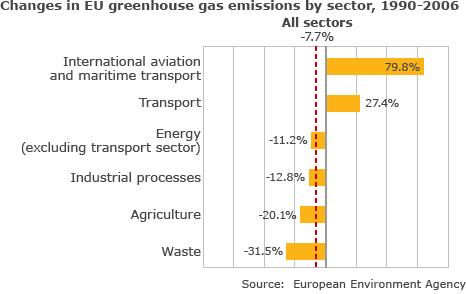
Sectors not covered by the ETS account for about 60% of all EU greenhouse gas emissions. Chief among these are road and sea transport, buildings, services, agriculture and smaller industrial installations.
The EU has agreed to cut emissions by 10% overall in these sectors in 2013-2020 - a contribution towards the total 20% cut. These sectors face binding national targets for emission cuts, in what is called "effort sharing". Gradually they will also be brought into the ETS.
The whole car industry has been set an average emission target of 120g of CO2 per kilometre by 2012 for new cars, compared with current levels of 160g/km. The target for 2020 is 95g/km. But CO2 emissions vary from car to car, and manufacturers have been given until 2015 to meet their specific targets for each model.
A key area of green innovation is carbon capture and storage (CCS) - new technologies that allow industrial CO2 emissions to be captured and stored underground, where they cannot harm the climate.
There are plans to build 10 to 12 big pilot plants in the EU by 2015, with a view to making CCS commercially viable by about 2020. The plants would be funded by revenue from the ETS.
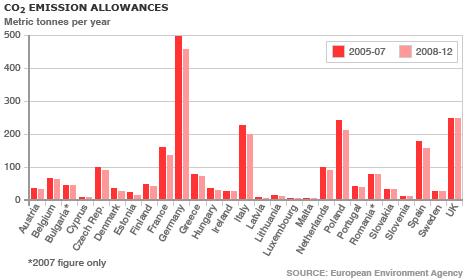
RENEWABLES
The EU package sets the goal of increasing renewable energy's share of the market to 20% by 2020, from around 8.5% today.
Within that goal, 10% of transport fuels will have to come from renewables, including biofuels. The commission wants a strict certification system to ensure that only biofuels achieving a real cut of at least 35% in CO2 emissions will be allowed.
The use of food-based biofuels is under review because of concern about deforestation and food shortages in developing countries.
The renewables targets for member states differ because they are at different stages in their use of wind energy, solar power, hydroelectric power and other green sources. The UK's proposed target is 15% by 2020, because the UK is far behind many other EU countries in the area of renewables.
The commission says the EU must embrace renewables not only to slow climate change but also because the EU's reliance on imported gas is set to increase from 57% currently to 84% by 2030, and on imported oil from 82% to 93%.
The creation of new jobs in renewable energy technologies is another benefit, the commission argues.
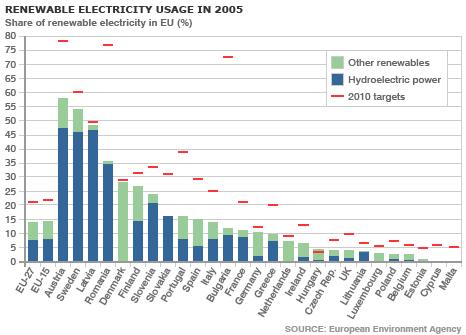
ENERGY EFFICIENCY
Energy consumption is to be cut by 20% by 2020 through improved energy efficiency, the package says.
The commission says state aid can legitimately be used to promote emissions cuts and increase take-up of renewables, so long as it does not breach EU competition rules.
The commission has come up with new proposals for the EU to co-finance national and local schemes to promote energy-efficient housing.
If the plan is adopted, the EU will help member states install double glazing, wall insulation and solar panels in housing, especially targeting low-income households.
The residential sector accounts for 25% of Europe's energy consumption, the commission says.